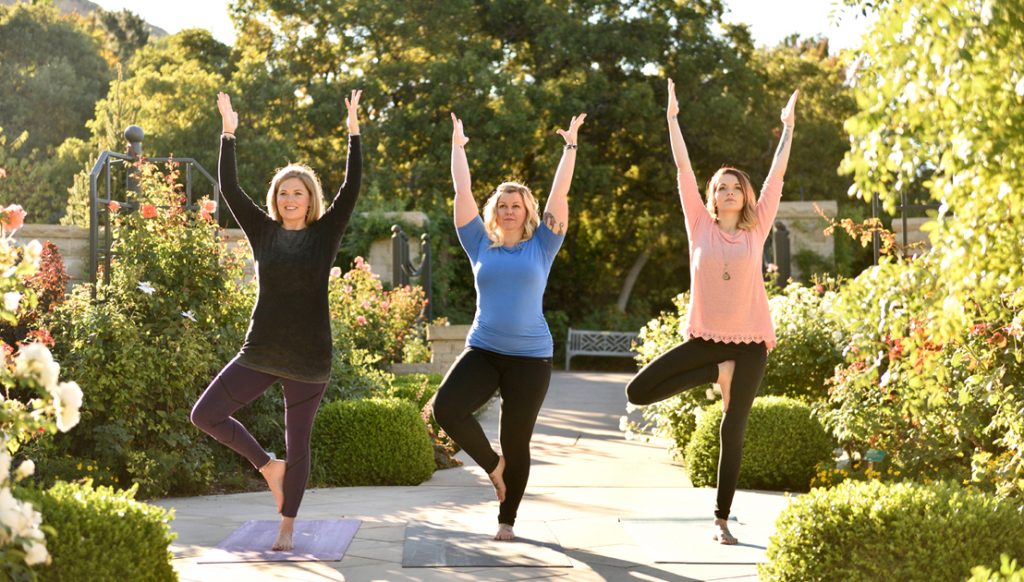6 Elements of Good Balance
According to the Centers for Disease Control (CDC), falls are the leading cause of injury or injury-related death in older adults in the United States. There are many reasons that older adults are more susceptible to falling, and to suffering serious injury after a fall. Bone and muscle loss are a natural part of aging, sapping our strength and stability. Hearing impairment can affect your vestibular system’s ability to keep you in balance. Some common prescription drugs can cause dizziness. The good news is that yoga can help. In future posts, I’ll make suggestions for yoga practices that can help us build balancing skills. In today’s post, I’ll describe six factors to consider when creating a practice for good balance.
Good Balance is More than Just Tree Pose
Practicing Tree Pose (Vrksasana) can definitely be a part of your balance-building regimen. But there’s more to it. Maintaining good balance over your lifetime requires considering the whole body/mind spectrum, and yoga can go a long way toward honing the skills that contribute to balance.
Here’s a list of what I know to be elements of steady balance. There may well be more that I haven’t learned about yet. This is an ongoing area of study for me, so I’d love to hear from readers who can share more information.
Element #1: Strong, Sensitive Feet
Our feet are our foundation. And yet, we tend not to give them the attention they deserve. Our feet can lose sensitivity over time, due to neuropathy, keeping them in tight or ill-fitting shoes, and due to general aging. In order to maintain good balance, our feet need to be strong, mobile and sensitive. Strength requires using them—walking, running, practicing yoga’s standing poses. Our toes are intimately involved in balance, so they need to be able to move freely. It’s also important to be able to feel how our feet are articulating with the ground, so we can detect when our feet are grounding unevenly.
Element #2: Bone and Muscle Strength
You may be surprised to learn that muscle mass begins to decrease in our 30s. It’s true, and the rate of decrease accelerates around age 60. Muscle strength and mass are crucial in maintaining bone health. Weight-bearing exercise like yoga and strength training can help us maintain overall muscle and bone health.
Element #3: Core Strength
A strong core—both abdominal muscles and back muscles—stabilizes the whole body, helping us maintain good balance. In turn, balancing exercises can help us maintain a strong core. Think poses like Boat Pose (Navasana), Bridge Pose (Setu Bandhasana) and the baby backbends like Locust Pose (Salabhasana).
Element #4: Flexibility
It’s inevitable that we will, at times, lose our balance. But when we do, it’s important that our bodies are able to recover, which can help prevent us from falling when we lose our balance. This means that we have to have movement options. A body with stiff joints simply will be less likely to stay upright when we trip, twist an ankle or falter while walking on uneven ground. Yoga, of course, is especially suited to promoting flexibility.
Element #5: Vestibular System
According to the Cleveland Clinic: “The vestibular system includes sensory organs in your inner ear that help you maintain your sense of balance. We’re constantly in motion, and so is the world around us. The vestibular system, when it’s working, helps your body understand how you’re moving and how things around you are moving to help maintain your balance or steadiness.” Yoga is unique among physical practices in that many of the poses require our heads to be in positions other than upright, which stimulates and strengthens our vestibular system.
Element #6: Concentration
Many falls happen when we’re simply not paying attention. We may be hiking on uneven terrain and thinking about something else entirely when we trip over a rock and fall. Or we may be practicing Tree Pose and lost in thought when our balance suddenly falters. In any case, paying attention to our movements, our environment, our posture, the relationship of our feet to the ground—all these things can help us balance. Mindfulness practice is key to helping us develop concentration skills.
In Conclusion: Build a Yoga Practice for Good Balance
In fashioning a yoga practice for good balance, we need to consider all these elements. Over the coming weeks, and perhaps, months, I’ll be sharing practices I know to be helpful. Yoga can be a wonderful ally in keeping us upright. In the meantime, practice poses you know to strengthen, stabilize, stretch and promote steady balance.
Leave a Reply Cancel reply
Recent Comments
Archives
- November 2025
- October 2025
- September 2025
- August 2025
- July 2025
- June 2025
- May 2025
- April 2025
- March 2025
- February 2025
- January 2025
- December 2024
- November 2024
- October 2024
- September 2024
- August 2024
- July 2024
- June 2024
- May 2024
- April 2024
- March 2024
- February 2024
- January 2024
- December 2023
- November 2023
- October 2023
- September 2023
- August 2023
- July 2023
- May 2023
- March 2023
- August 2022
- July 2022
- June 2022
- May 2022
- April 2022
- March 2022
- February 2022
- January 2022
- December 2021
- November 2021
- October 2021
- September 2021
- August 2021
- July 2021
- June 2021
- May 2021
- April 2021
- March 2021
- February 2020
- January 2020
Theme by The WP Club . Proudly powered by WordPress
